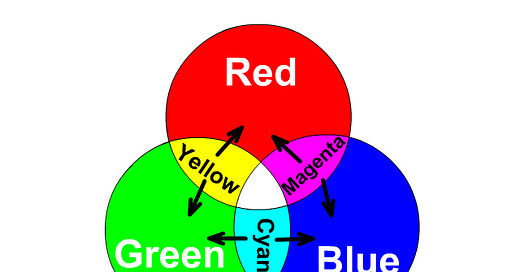Color Theory: Physics Honors Final Exam Review (My Discord!!!!)
Light v Paint, from a 9th grader
Alola!
After a long time, I’m back, today with some final review problems that I made and shared with some of my classmates in preparation for our Honors Physics final exam, the subtopic being Color. Keep reading to get my discord!
Enjoy!
Notes: Color Theory FINAL EXAM REVISION
Property of Pigmentation (Light), Long Version: We have already discussed that the white light is a mixture of seven different colors. When this white light consisting of seven colors falls on an object, then that object absorbs all the colors of the white light except one colour, which it reflects. And it is the colour of the reflected light which determines the colour of that object. For example, a rose (or blood) appears red in sunlight because when white light falls on rose (or blood), it absorbs all the colors of white light except red colour, which it reflects. This reflected red light by rose (or blood) enters our eyes and we feel the sensation of red colour. In the same way the leaves of plants appear green in sunlight because when white light falls on leaves, they reflects green colour to our eyes and absorbs all other colors. This reflected green light enters our eyes and we feel the sensation of green colour.
Light Properties
The primary colors are Red, Green, and Blue, RGB respectively. All other colors of light may be made out of an addition of these three colors
ADDITIVE MODEL: Define the additive color model as the mechanism in which colors, when added on top of each other, make a lighter color, aka they combine positively... RGB is an additive color model
If a red beam is shined in the same vicinity as a green beam, it will result in a yellow image.
If a red beam is shined in the same vicinity as a blue beam, it will result in a magenta image.
If a blue beam is shined in the same vicinity as a green beam, it will result in a cyan image.
All three 'additions' of the primary colors are secondary colors
Substitution Property: Any color in any given problem may be broken down as the addition of their primary origins. For example, a Magenta beam is equivalent to an ‘RB’ beam. (See 3, 4, 5, 6 of Light Properties)
Property of Complementary Absorption (Specific): Any primary or secondary color will always completely absorb it’s complement. The complement of a color is the opposite type of color (secondary and primary respectively) that contains none of this color. Eg. Cyan is the complement of Red.
PAINT Properties (it's different!!!!)
The primary colors are Cyan, Magenta, and Yellow (and Key/Black), CMY(K) respectively. All other colors of paint may be made out of an SUBTRACTION of these three colors
SUBTRACTIVE MODEL: Define the subtractive color model as the mechanism in which PAINT colors, when added on top of each other, make a DARKER color, aka they combine NEGATIVELY... CMYK is a subtractive color model— instead being able to reflect more colors when mixed, they ABSORB more colors.
All three 'subtractions' of the primary colors are secondary colors.
Property of Pigmentation (IMPORTANT!!!): Any physical object with color X will ONLY reflect light of the color X and the primary colors ABC making up X, and absorb any other color Y. This property only works in the SUBTRACTIVE model— eg. Magenta beams are not “absorbed” by green ones because the system of light is an ADDITIVE one— aka in the realm of PHYSICAL objects.
Property of SUBTRACTION (different than light!) : To determine what CMYK mixes to form which color of paint, use the subtractive property--
Eg: Mix Cyan and Magenta (two-column, ELI 5)
1. Substitution Property, P | Decompose Cyan into GB and Magenta into RB
2. Property of Pigmentation, 1 | Cyan ONLY reflects GB and Magenta ONLY reflects RB
3. Property of Complementary Absorption, 2 | Cyan absorbs R and Magenta absorbs G
4. Definition of RGB, P | RGB comprises all colors
5. Subtractive Model, 1, 2 | Colors subtract, increasing the amount of colors being absorbed; G and R are subtracted.
6. Subtractive Model, 3, 5 | Only B is still reflected, while R and G are absorbed
7. QED, 4
Get it? If not, look back at the statement numbers in the proof to see which statements I’m referring. if you have any questions, feel free to comment!
Thanks, and happy finals season!
Discord: LaImperial#3831


